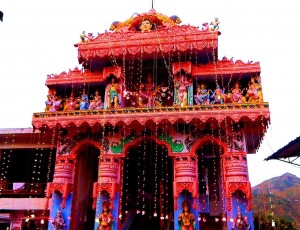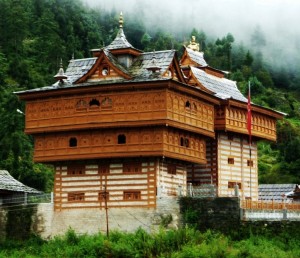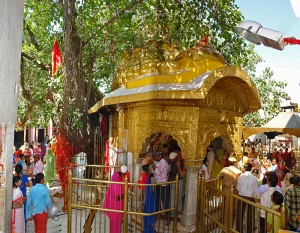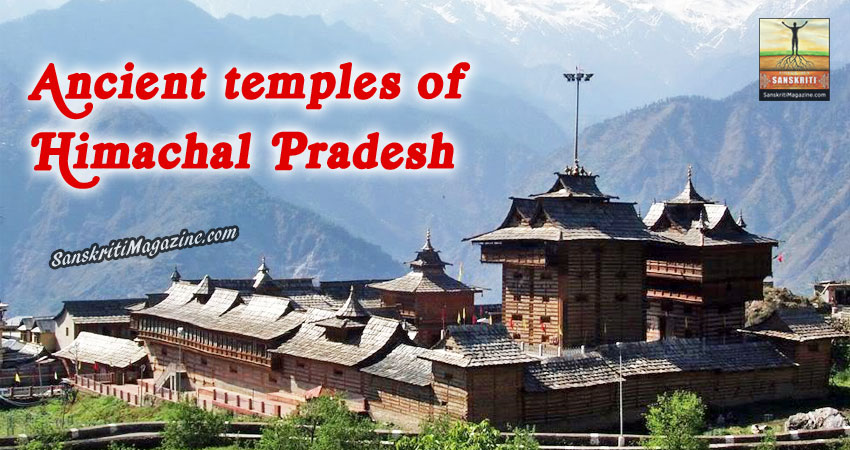Baba Baroh
Baba Baroh is a tehsil in Kangra district, India is recognized for a temple made of white marble to Radha Krishan and the Goddess Durga. This temple is well-known for the largest amount of white marble used for any temple in Himachal Pradesh. Baba Baroh is located 23 km away from Kangra. In this temple there is an idol of Goddess Durga made of metal.
Baijnath Temple
The Baijnath Temple is located in Himachal Pradesh, India, and is over 1,000 years old.
Bhalei Mata Temple
 Bhalei Mata Temple is the temple of Bhadar Kali widely known as Sri Bhalei Mata. It is located on a dazzling spur 3800 feet high at a place called Bhalei, which is now a Sub-Tehsil headquarters. It is about 25 km away from Salooni Tehsil headquarters. The sanctity is in the frontal of an image of black stone of two feet height and is enshrined in the sanctum sanctorum of the temple. Bhadar Kali draws a large number of pilgrims from far and wide. An immense havana ceremony is performed during navratras of Ashwin and Chait months.
Bhalei Mata Temple is the temple of Bhadar Kali widely known as Sri Bhalei Mata. It is located on a dazzling spur 3800 feet high at a place called Bhalei, which is now a Sub-Tehsil headquarters. It is about 25 km away from Salooni Tehsil headquarters. The sanctity is in the frontal of an image of black stone of two feet height and is enshrined in the sanctum sanctorum of the temple. Bhadar Kali draws a large number of pilgrims from far and wide. An immense havana ceremony is performed during navratras of Ashwin and Chait months.
Mythology has a fact that the temple of Bhadar Kali was built originally by Raja Pratap Singh during his reign. He was a religiously disposed king and has to his credit construction, repair and renovation of many temples in the district. The legend is that the idol came to Raja Partap Singh’s dream and told him that she was lying hidden in a place called Bhran about three kilometres away from the present site of temple. The idol asked the Raja to bring her from Bhran and erect a suitable temple for her.
The Raja with his officials went to the Bhran and discovered the image. The Raja and his team were very happy becuase they had already decided to construct a temple for the idol in Chamba town. So they started their journey back. On the way back they thought to rest for sometime at Bhalei and when they restarted their journey, the bearers could not lift the palanquin of the idol in which she was being taken to Chamba. A Brahman from Kilod village was invited to construe this peculiar incident. The Brahaman said that the deity did not want to go to Chamba, rather she desired her temple to be hoisted at the site.
According to another belief, the people of this area were not happy regarding the idea of the idol being taken to Chamba, so they requested the Raja to construct the temple at Bhalei. Whatever be the precedence, the temple was built at Bhalei by Raja Partap Singh and later renovated by Raja Sri Singh. Recently a lot of renovation work has been carried out. Statue of Bhader Kali was unfortunately stolen in the year 1973 by antique thieves but happily recovered at Chohra near the present dam site. It is believed that the image of the idol seems to be perspiring since that event.
Bhimakali Temple
Shri Bhima Kali Temple located at Sarahan in Himachal Pradesh in India, dedicated to the mother goddess Bhimakali, presiding idol of the rulers of former Bushahr State. The temple is 180 kilometer away from Shimla and it is one of 51 Shakti Peethas. The town Sarahan is known as the gate way of Kinnaur. Down below at a distance of 7 km from Sarahan is the River Satluj. Sarahan is identified with the Sonitpur mentioned in Puranas.
Legend about Bhimakali
 According to the legend, the demonstration of the goddess is reported to the Daksha-Yajna incident when the ear of the Sati fell at this place and became a place of worship as a Pitha – Sthan. Presently in the form of a virgin the icon of this eternal goddess is sanctified at the top storey of the new building. Below that storey the goddess as Parvati, the daughter of Himalaya is enshrined as a divine consort of Lord Siva.The temple complex has another three temples dedicated to Lord Raghunathji, Narsinghji and Patal Bhairva Ji (Lankra Veer) – the guardian deity.
According to the legend, the demonstration of the goddess is reported to the Daksha-Yajna incident when the ear of the Sati fell at this place and became a place of worship as a Pitha – Sthan. Presently in the form of a virgin the icon of this eternal goddess is sanctified at the top storey of the new building. Below that storey the goddess as Parvati, the daughter of Himalaya is enshrined as a divine consort of Lord Siva.The temple complex has another three temples dedicated to Lord Raghunathji, Narsinghji and Patal Bhairva Ji (Lankra Veer) – the guardian deity.
Sarahan was the capital of rulers of former Bushahr State. Bushahr dynasty earlier used to control the state from Kamroo. The capital of state later was moved to Sonitpur. Later Raja Ram Singh made Rampur as the capital. It is believed that the country of Kinnaur was the Kailash mentioned in Puranas, the abode of Shiva. With its capital at Sonitpur this former princely state was protracted up to entire area ofKinnaur where sometimes Lord Shiva disguised himself as Kirata. Today, Sonitpur is known as Sarahan. Banasura, the ardent devotee of Lord Siva, eldest among the one hundred sons of great ablative demon King Bali and the great grandson of Vishnu votary Prahlad, during the Puranic age was the ruler of this princely state.
Bijli Mahadev
Bijli Mahadev is one of the sacred temples of the Indian states, Himachal Pradesh. It is located at an altitude of about 2,438 m in the Kullu Valley. Bijli Mahadev is one of the finest temples in India. The temple is Located 10 km away from Kullu across the Beas River, it can be approached by a rewarding trek of 3 km. A panoramic view of Kullu and Paravati valleys can be seen from the temple. The 60 feet high staff of Bijli Mahadev temple twinkles like a silver needle in the sun. In this temple of lightning it is said that the tall staff attracts the divine blessings in the form of lightning. It is believed that the priest of the temple has to restore the Shiva linga placed inside the temple using butter and sattoo after every lightning as it shatters to pieces with flash of lightning.
Chintpurni
Chintpurni is a place of pilgrimage and one of the Shakti Peethas in India. The Chintpurni shakti peeth (Chhinnamastika shakti peeth) is located in Una district Himachal Pradesh state, surrounded by the western Himalaya in the north and east in the smaller Shiwalik (or Shivalik) range bordered by the Punjab state. The Chintpurni Shakti Peeth is dedicated to the temple of Chinnamastika Devi or Chinnamasta Devi. Chhinnamasta or Chinnamastika temple is one of the 7th major and 51 total Shakti Peethas. Here, Chhinnamasta is interpreted as the severed-headed one as well as the foreheaded-one.
When Lord Vishnu chopped the body of Sati into 51 pieces so that Lord Shiva would calm down and stop his Tandava, the pieces were scattered over various places in the Indian subcontinent. It is believed that parts of Sati’s feet fell at this place and it is considered as one of the most important of the 51 Shakti Peethas.
The goddess resident in Chintpurni is also known by the name of Chhinnamastika. According to Markandeya Purana, goddess Chandi defeated the demons after a fierce battle but two of her yogini emanations (Jaya and Vijaya) were still thirsty for more blood. Goddess Chandi cut off her own head to quench Jaya and Vijaya’s thirst for more blood.She is usually shown holding her own severed head in her hand, drinking one stream of blood spurting from the arteries in her neck, while at her side are two naked yoginis, each of them whom drinks another stream of blood.
Chhinnamasta, the headless goddess, is the Great Cosmic Power who helps the sincere and devoted yogi to dissolve his or her mind, including all the preconceived ideas, attachments and habits into the Pure Divine Consciousness. Chopping off the head suggests the separation of the mind from the body, that is the freedom of the consciousness from the material confines of the physical body. According to Puranic traditions, Chhinnamastika Devi will be protected by Shiva – Rudra Mahadev in the four directions. There are four Shiva temples – Kaleshwar Mahadev in the east, Narayhana Mahadev in the west, Muchkund Mahadev in the north and Shiva Bari in the south – which are nearly equidistant from Chintpurni. This also confirms Chintpurni as the abode of Chhinnamastika Devi.
The Chintpurni Temple as a Shakti Peeth
 The Chinna Mastika Devi is a divine embodiment of self-sacrifice and there by the Chintpurni Shri is considered as a Shakti Peetha. The mythology of Daksha yaga and Sati’s self immolation is the mythology liked to the Shakti Peethas. Shakti Peethas are holy shrines of Shakti associated with a mythology that says about the falling of body parts of the corpse of Sati Devi, when Lord Shiva carried it and amble in sorrow. There are 51 Shakti Peeth associated with the 51 alphabets in Sanskrit. It is believed that Sati Devi’s feet fell here.
The Chinna Mastika Devi is a divine embodiment of self-sacrifice and there by the Chintpurni Shri is considered as a Shakti Peetha. The mythology of Daksha yaga and Sati’s self immolation is the mythology liked to the Shakti Peethas. Shakti Peethas are holy shrines of Shakti associated with a mythology that says about the falling of body parts of the corpse of Sati Devi, when Lord Shiva carried it and amble in sorrow. There are 51 Shakti Peeth associated with the 51 alphabets in Sanskrit. It is believed that Sati Devi’s feet fell here.
The temple devoted to Mata Chintpurni Devi which is located in District Una of Himachal Pradesh. Mata Chintpurni Devi is also known as Mata Shri Chhinnamastika Devi. Devotees have been visiting this Shaktipeeth for centuries to pray near the lotus feet of Mata Shri Chhinnamastika Devi Devotees bring with them all their secular burdens and seek blessings from the Devi. It is believed that all our dreams come true if we visit once there in a life.Apart from the holy shrine, the place is full of picturesque surroundings. Some of the fair places for sightseeing, private and outside activities are placed in and around Chintpurni. Chintpurni is very well linked through roads and marvellous hotels around chintpurni and dharamsala erected in and around Chintpurni, Tourists will not have to face any issues regarding accommodation. People can visit temples and they can come for holiday trips with great enthusiasm and can have a wonderful time and memories.
Pandit Mai Das, a Saraswat Brahman, believed to have the shrine of Mata Chintpurni Devi entrenched in Chhaproh village in the ancient times. By the time of eponymous deity this place is known as Chintpurni. His descendants still live in Chintpurni and do prayers and puja at the Chintpurni temple. These descendants are the authoritative priests at the Temple.
Hindu pilgrimage and marriage testimonials are kept at this holy place. The Genealogical Society (GSU) of Utah, USA has microfilmed Hindu pilgrimage testimonials for Haridwar and several other Hindu pilgrimage centres. Priests (pandits) located at each site would record the name, date, home-town and purpose of visit for each pilgrim. These records are organized according to family and ancestral home. The assets by GSU include Haridwar, Kurukshetra, Pehowa, Chintpurni, Jawalapur and Jawalamukhi.











